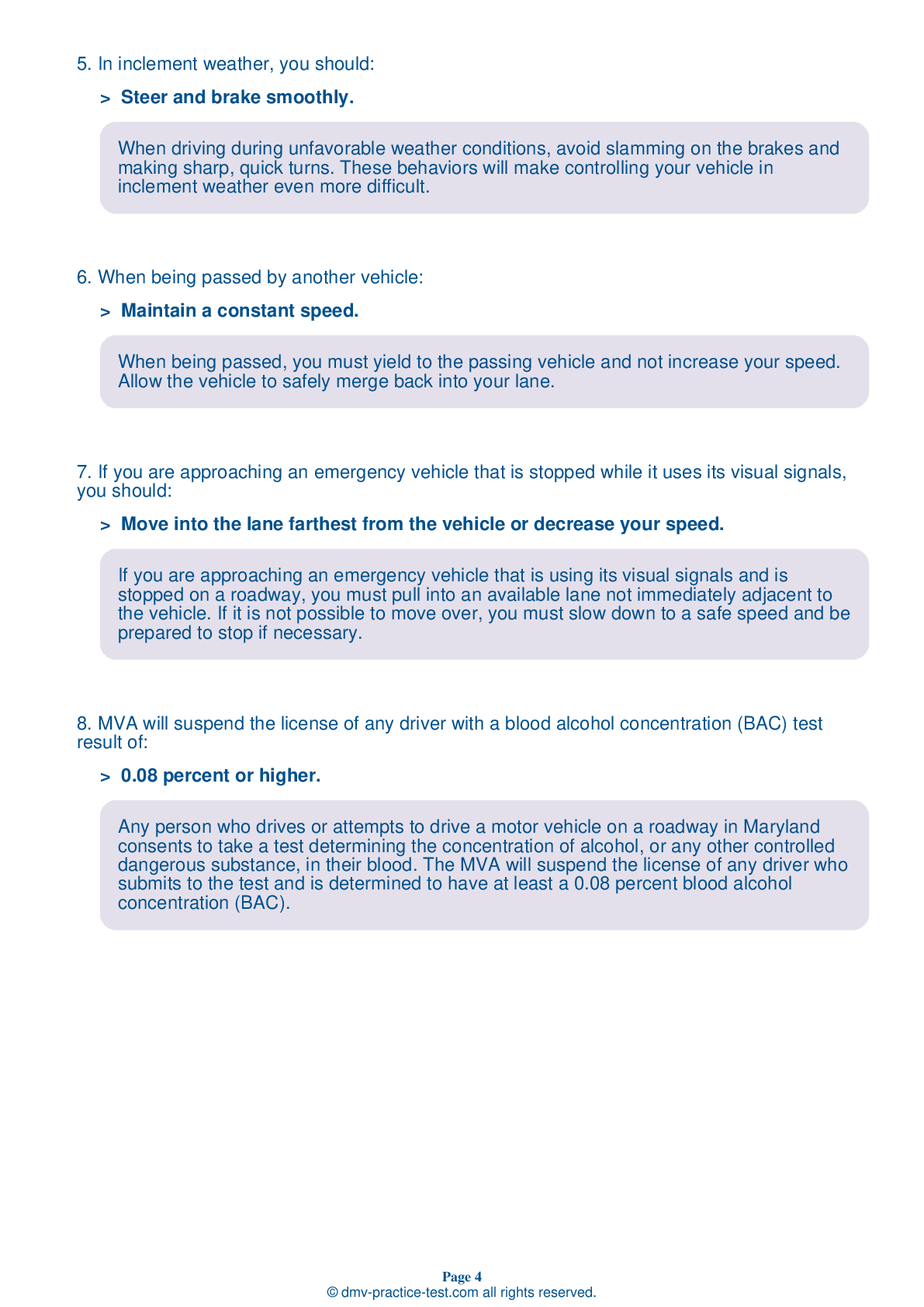FREE Maryland DMV Practice Test #1 Page 3 of 3
Maryland DMV practise examinations have been updated for January 2025. It includes questions based on the Maryland Driver Handbook's most essential traffic signals and regulations for 2025. Use actual questions that are very similar (often identical!) to the DMV driving permit test and driver's licence exam to study for the DMV driving permit test and driver's licence exam.
On the practise exam, each question gets a tip and explanation to help you remember the concepts. The written component of the official Maryland DMV test will include questions about traffic rules, traffic signs, and driving statutes, as well as knowledge from the Driver Handbook.
To obtain a passing grade, you must correctly answer 22 of the 25 questions. Take our DMV practise exam to help you prepare for your Maryland instruction permit or driver's licence.
The DMV exam is available in several languages.
Using any kind of testing assistance will result in an automatic fail, and the DMV may take additional action against your driver's licence, so stay away from it.
17 . If you come to an intersection and your view to the side is blocked, you should:
Drivers must slow down when approaching an intersection. If a clear view of cross traffic is obscured, a driver should come to a stop and inch forward until they can see clearly in both directions.
18 . Sudden wind gusts on highways:
While it can create special problems for large vehicles, strong wind can cause problems for all drivers. Wind can lower visibility by blowing dirt and dust into the roadway, but it can sometimes also physically move a vehicle.
19 . If pedestrians are illegally crossing in the middle of the street instead of in a crosswalk, you:
You must yield to pedestrians at all times. If the pedestrians are jaywalking or crossing the street where they should not be, you must still stop for them.
20 . "Implied consent" means:
Any person who drives or attempts to drive a motor vehicle on a roadway in Maryland consents to take a test determining the concentration of alcohol, or any other controlled dangerous substance, in their blood. The MVA will suspend the license of any driver who submits to the test and is determined to have at least a 0.08 percent BAC.
21 . If you drive faster than other vehicles on a road with one lane moving in each direction and continually pass the other cars, you will:
You should avoid passing other vehicles on two-lane roads. Every time you pass a vehicle, your odds of being in a collision increase.
22 . If you can see that the roadway up ahead is covered by heavy smoke, you should:
If you notice that the road ahead is covered by heavy smoke, reduce your speed immediately, drive as far as possible to the right, and stop off the roadway. Only then should you determine if it is safe for you to continue. Remember that certain kinds of smoke can irritate your eyes and lungs or even kill you.
23 . A driver is responsible for ensuring that any child under the age of eight and shorter than ____ be seated in a federally-approved child passenger safety device system while in a moving vehicle.
Maryland law requires children who are under the age of eight and less than 4 feet, 9 inches in height to be seated in federally-approved child safety seats while in moving vehicles. The driver of a vehicle transporting child passengers is responsible for their safety.
24 . At a stop sign, you:
When approaching a stop sign, a driver must come to a complete stop before proceeding. After stopping, when it is safe to do so, the driver may then continue through the intersection.
25 . What is a potential effect of taking a prescription drug while drinking alcohol?
Legal medications, both prescription and over-the-counter, can impair your ability to drive. They can be particularly dangerous when used in combination with alcohol.
Need Car Insurance? No problem!
Compare the best rates in Maryland and find a personalized policy that meets your needs.
1. Are You Currently insured ?
2. Married ?
3. Do you own your Home?
4. Do you have more than 1 car ?
5. Have you or a Family Member Honorably Served in U.S. Military ?
6. Your Name
7. Age
8. Zip code
IMPORTANT REMINDER:Auto Insurance is Mandatory to drive in Maryland. Get covered before you hit the road to avoid any fines.
Ranked by best match
2025 Maryland | Frequently Asked Questions
1. Be at least 15 years and 9 months old.
2. Pass the vision exam.
3. Complete the Maryland MVA Online Driver Test Tutorial.
4. Pass the knowledge test.
5. Provide proof of identity, age, and Maryland residency.
6. Have a parent or guardian co-sign your application.
7. Pay the required fee.
Remember, you must hold your learner's permit for nine months before you can take the driving test.



